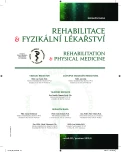Evaluating the Quality of Life of Patients with Spinal Cord Injury
Authors:
M. Ležovič; Z. Holosova; M. Mucska
Authors‘ workplace:
Fakulta verejného zdravotníctva SZU v Bratislave
dekan doc. MUDr. Š. Moricová, Ph. D., MPH
Published in:
Rehabil. fyz. Lék., 20, 2013, No. 4, pp. 204-210.
Category:
Original Papers
Overview
The article concentrates on evaluation of the quality of life in patients with spinal cord injury. The authors set to investigate the way the patients with spinal cord injury feel and evaluate the quality of life, which aspects of the quality of life influence the subjective perception of general quality of their life, and which aspects of the quality of life particularly influence their satisfaction with their own health. The authors addressed the patients of the National Rehabilitation Center (NRC) in Kováčová in June 2012, who had been subject to injury more than a year ago. The questionnaire method was employed using a shortened version with 26 items of the standardized WHOQOL–BREF questionnaire of the quality of life The cohort encompassed 64 patients with spinal cord injury. The analysis of the research results revealed that most patients evaluated the quality of life at a good level and satisfaction was felt as of medium degree in relation to the time period from the injury and diagnosis. The authors suggest that a similar research could be made at a larger scale in order to get results which would give a more relevant answer for the quality of life of physically handicapped individuals, the elaboration of a method algorithm for provision of medical care, for creation of legislative conditions for removing the barriers, the space for higher self-sufficiency and placement into working life, for job-related, sport, cultural-social and outside interests/hobby activities in individual regions of Slovakia.
Keywords:
quality of life, management, patient with spine cord injury, health satisfaction, WHOQOL–BREF questionnaire
Sources
1. CASTRO, M. D. G.T., OLIVEIRA, M. D. S., MIGUEL, A. C., ARAUJO, R. B.: WHOQOL-BREF psychometric properties in a sample of smokers. Revista Brasileira de Psiquiatria, 29, 2007, 3, s. 254-257.
2. JAHODOVÁ, J.: Kvalita života pacienta s míšním poraněním. Diplomová práca. Brno, Masarykova univerzita, 2007, 71 s.
3. Ležovič, M.: Kvalita života dialyzovaných pacientov. Lekársky obzor, 60, 2011, č.2, s. 70-75.
4. MALÝ, M. a kol.: Poranenie miechy a rehabilitácia. 1. vyd., Bratislava, Bonus Real., 1999, 577 s.
5. MALÝ, M.: Ako ďalej po poranení mechy. 1. vyd., Slovenská Ľupča, Obalotava, 2010, 144 s.
6. MORENO, A. B., FAERSTEIN, E., WERNECK, G. L., LOPES, C. S., CHOR, D.: Psychometric properties of the world health organization abbreviated instrument for quality of life assessment in the pró-saúde study. Cadernos de Saude Publica, 22, 2006, 12, s. 2585-2597.
7. POWER, M., KUYKEN, W.: World health organization quality of life assessment (WHOQOL): Development and general psychometric properties. Social Science and Medicine, 46, 1998, 12, s. 1569-1585.
8. SLEZÁKOVÁ, Z., REHOZSKÁ, D.: Kvalita života u pacientov s lumboischiadickým syndrómom. Rehabilitácia, 49, 2012, 2, s. 110-118.
9. TÓTH, S.: Kvalita života ako determinant subjektívneho hodnotenia životnej pohody v rámci rehabilitácie u chirurgických pacientov. Rehabilitácia, 49, 2012, 2, s. 72-79.
10. VAŇÁSKOVÁ, E., BEDNAR, M.: Testovaní kvality života v neurorehabilitaci. Rehabilitácia, 50, č. 1, 2013, s. 7-11.
11. VON STEINBÜCHEL, N., LISCHETZKE, T., GURNY, M., EID, M.: Assessing quality of life in older people: Psychometric properties of the WHOQOL-BREF. European Journal of Ageing, 3, 2006, 2, s. 116-122.
Labels
Physiotherapist, university degree Rehabilitation Sports medicineArticle was published in
Rehabilitation & Physical Medicine

2013 Issue 4
- Hope Awakens with Early Diagnosis of Parkinson's Disease Based on Skin Odor
- Deep stimulation of the globus pallidus improved clinical symptoms in a patient with refractory parkinsonism and genetic mutation
Most read in this issue
- Combined Training of Closed and Open Kinematic Chains in Rehabilitation Exemplified by the FLOWIN® System
- Osteochondral Articular Junction and Osteoarthrosis
- The Observation of the Dynamics of a Clinical Picture in a Chronic Cervicobrachial Syndrome with the Aid of the Principles of McKenzie Concept
- The Inclination and Shape Modulation of Cervicothoracic Connection of Spine Provoked by External Rotation of the Arm
